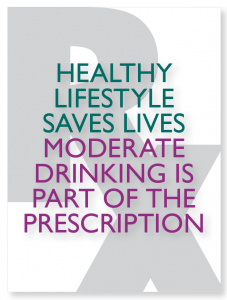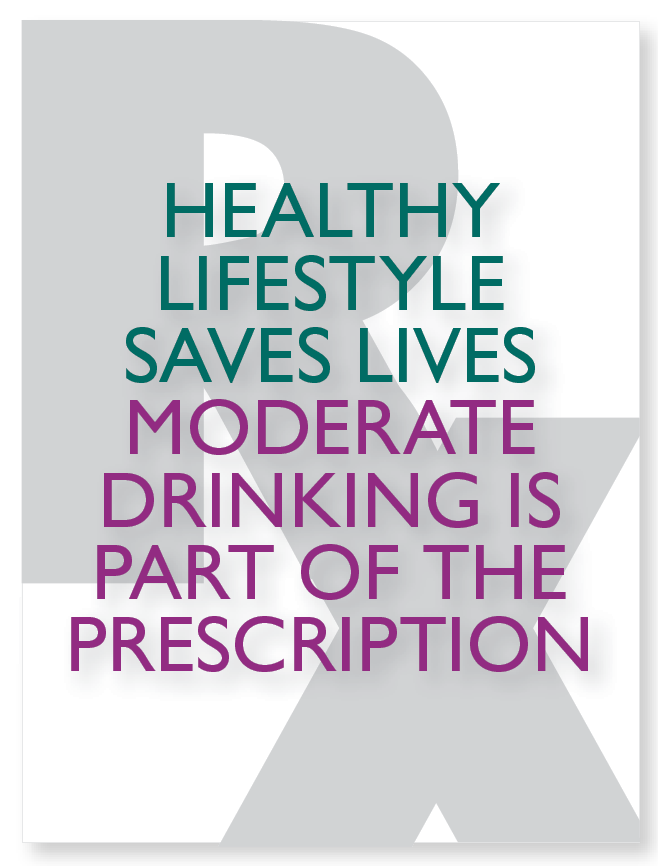HEALTHY LIFESTYLE SAVES LIVES MODERATE DRINKING IS PART OF THE PRESCRIPTION
 CARDIOVASCULAR DISEASE is the runaway leading cause of death and disability in the developed world, with heart attack (myocardial infarction) the most frequent coup de grâce. Although some basic inherited vulnerabilities can be modulated to a modest extent by medical intervention – such as treatment of high blood pressure, high cholesterol, high blood sugar, and hypercoagulability – we are discovering that altering lifestyle in a healthy way may be at least as effective.
CARDIOVASCULAR DISEASE is the runaway leading cause of death and disability in the developed world, with heart attack (myocardial infarction) the most frequent coup de grâce. Although some basic inherited vulnerabilities can be modulated to a modest extent by medical intervention – such as treatment of high blood pressure, high cholesterol, high blood sugar, and hypercoagulability – we are discovering that altering lifestyle in a healthy way may be at least as effective.
In a paper published in the JOURNAL OF THE AMERICAN COLLEGE OF CARDIOLOGY, September 3O, 2O14, Agneta Åkesson and colleagues from Stockholm’s respected Karolinska Institutet reported their eleven years of study of almost 21,OOO Swedish men, 45- to 79-years-old, designed to determine whether “healthy dietary and lifestyle practices may have an impressive impact on the primary prevention of myocardial infarction.”
The variables studied were five. Healthy diet had been defined by the National Health and Nutrition Examination Survey to include fruits, vegetables, legumes, nuts, reduced-fat dairy products, whole grains, and fish, as contrasted to non-recommended foods, including red and processed meats, fried potatoes, solid fats, full-fat cheeses, white bread, refined cereals, and various sweet foods. [Predictably, the unhealthy group tastes better to most people.] Moderate alcohol consumption was defined as 1O to 3O grams per day, and was compared to both less and more. [As wine, that would be about equivalent to an average of between 3.5 and 1O ounces per day.] Unfortunately, neither type of beverage nor pattern of drinking was addressed. Nonsmoking included never-smokers and those who had quit at least 2O years previously. Physical activity was considered a low-risk asset if it included both daily “nonexercise” such as walking and bicycling, and weekly more vigorous exercise according to specified criteria. Absence of abdominal adiposity (fat belly) meant a waist circumference of 37 inches or less. The subjects were required to have no history of cancer, cardiovascular disease, diabetes, hypertension, or high cholesterol level when inducted into the study.
The study results dramatically affirmed the potential benefits of the five factors. Each was independently associated with a reduction of heart-attack risk, and the respective benefits were additive. Led by nonsmoking, with a reduction of risk of heart attack of 36 percent, the others, in order, showed independent risk reductions of 18 percent (healthy diet), 12 percent (no abdominal adiposity), 11 percent (moderate alcohol), and 3 percent (physical activity). [I know of no way to determine whether any of these factors might influence, even confound, any of the others, but one can imagine scenarios.] Combining healthful practices yielded impressive numbers. For example, healthy diet with moderate alcohol consumption gave a heart-attack risk reduction of 35 percent. Men stalwart enough to exhibit all five favorable characteristics had a risk of only 14 percent of the highest-risk subgroup’s, 21 percent of the risk of the total study’s population. This elite segment, however, constituted only one percent of the total study group. An associated study of subjects with hypertension and high cholesterol at baseline demonstrated similar results. The investigators concluded that four out of five heart attacks may be preventable.
Although encouraging, that fate is not inexorable. These findings are by no means astonishingly new – a number of other competent researchers have reported healthy behavior or lifestyle to be associated with reduced risk of illness or even of death. I was impressed by the study that Ford, et al., of the US Centers for Disease Control and Prevention (CDC) published in the AMERICAN JOURNAL OF PUBLIC HEALTH (2O11;1O1:1922-1929). As discussed in this space in May, 2O13, they found that deaths from all causes, deaths from cardiovascular disease (chiefly heart attacks and strokes), and deaths from cancer were reduced in American women and men, age 17 and older, in association with four “low-risk lifestyle behaviors”: never smoking, healthy diet, adequate physical activity, and moderate alcohol consumption (defined in that study as up to 3O drinks per month for women, 6O for men). As in the Swedish study, each behavior’s benefit was additive to the others’. The benefit associated with not smoking was the largest, showing up particularly as a sharp decrease of cancer deaths. Moderate drinking appeared to especially decrease deaths from cardiovascular disease.
For most of us, most of these healthful practices are easier to read about than to live by. Perhaps their urgency is in part determined by the genetic background of each individual, the power of prediction of which is progressively improving. Eating one’s vegetables, faithfully performing repetitive exercises and not smoking will be less onerous for those brought up to do so from childhood. Moderate drinking is most often the product of growing up in a home of moderation.

